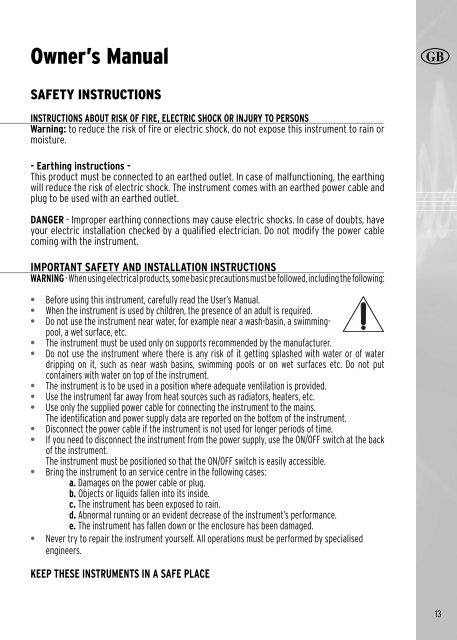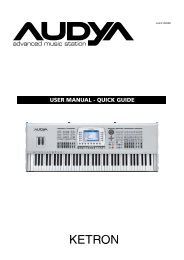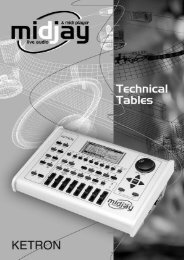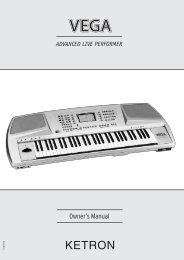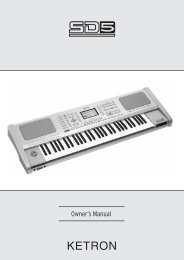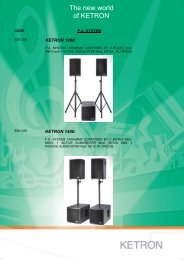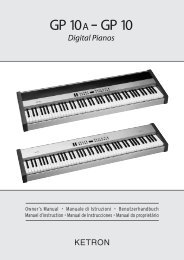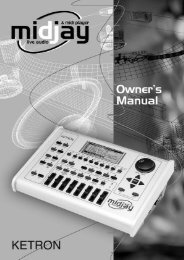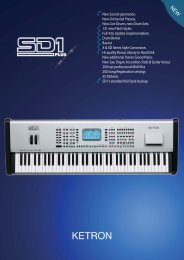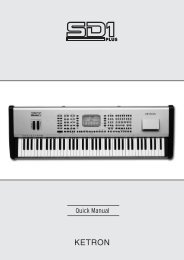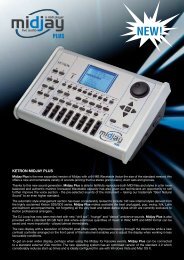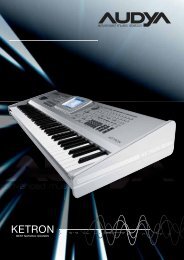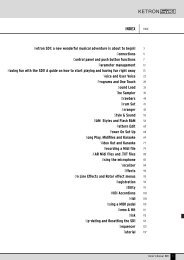Create successful ePaper yourself
Turn your PDF publications into a flip-book with our unique Google optimized e-Paper software.
Owner’s <strong>Manual</strong>GBSAFETY INSTRUCTIONSINSTRUCTIONS ABOUT RISK OF FIRE, ELECTRIC SHOCK OR INJURY TO PERSONSWarning: to reduce <strong>the</strong> risk of fire or electric shock, do not expose this instrument to rain ormoisture.- Earthing instructions -This product must be connected to an ear<strong>the</strong>d outlet. In case of malfunctioning, <strong>the</strong> earthingwill reduce <strong>the</strong> risk of electric shock. The instrument comes with an ear<strong>the</strong>d power cable andplug to be used with an ear<strong>the</strong>d outlet.DANGER - Improper earthing connections may cause electric shocks. In case of doubts, haveyour electric installation checked by a qualified electrician. Do not modify <strong>the</strong> power cablecoming with <strong>the</strong> instrument.IMPORTANT SAFETY AND INSTALLATION INSTRUCTIONSWARNING - When using electrical products, some basic precautions must be followed, including <strong>the</strong> following:• Be<strong>for</strong>e using this instrument, carefully read <strong>the</strong> User’s <strong>Manual</strong>.• When <strong>the</strong> instrument is used by children, <strong>the</strong> presence of an adult is required.• Do not use <strong>the</strong> instrument near water, <strong>for</strong> example near a wash-basin, a swimmingpool,a wet surface, etc.• The instrument must be used only on supports recommended by <strong>the</strong> manufacturer.• Do not use <strong>the</strong> instrument where <strong>the</strong>re is any risk of it getting splashed with water or of waterdripping on it, such as near wash basins, swimming pools or on wet surfaces etc. Do not putcontainers with water on top of <strong>the</strong> instrument.• The instrument is to be used in a position where adequate ventilation is provided.• Use <strong>the</strong> instrument far away from heat sources such as radiators, heaters, etc.• Use only <strong>the</strong> supplied power cable <strong>for</strong> connecting <strong>the</strong> instrument to <strong>the</strong> mains.The identification and power supply data are reported on <strong>the</strong> bottom of <strong>the</strong> instrument.• Disconnect <strong>the</strong> power cable if <strong>the</strong> instrument is not used <strong>for</strong> longer periods of time.• If you need to disconnect <strong>the</strong> instrument from <strong>the</strong> power supply, use <strong>the</strong> ON/OFF switch at <strong>the</strong> backof <strong>the</strong> instrument.The instrument must be positioned so that <strong>the</strong> ON/OFF switch is easily accessible.• Bring <strong>the</strong> instrument to an service centre in <strong>the</strong> following cases:a. Damages on <strong>the</strong> power cable or plug.b. Objects or liquids fallen into its inside.c. The instrument has been exposed to rain.d. Abnormal running or an evident decrease of <strong>the</strong> instrument’s per<strong>for</strong>mance.e. The instrument has fallen down or <strong>the</strong> enclosure has been damaged.• Never try to repair <strong>the</strong> instrument yourself. All operations must be per<strong>for</strong>med by specialisedengineers.KEEP THESE INSTRUMENTS IN A SAFE PLACE13
HOW TO AVOID RADIO/TV INTERFERENCEThis instrument operates at radio frequencies, and if not correctly installed according to <strong>the</strong>instructions supplied, it may cause interference with radio and television reception.Though this instrument has been designed according to <strong>the</strong> applicable standards andnotwithstanding <strong>the</strong> reasonable protections against interference it has been equipped with,<strong>the</strong>re is no guarantee that such events will not occur. In order to check if <strong>the</strong> interference isactually caused by this instrument, switch it off and see if <strong>the</strong> interference disappears.Then switch it on again and check if <strong>the</strong> interference appears again. Once you have made surethat <strong>the</strong> interference is originated by this instrument, take one of <strong>the</strong> following measures:• Modify <strong>the</strong> instrument’s position with respect to <strong>the</strong> receiver.• Increase <strong>the</strong> distance between <strong>the</strong> instrument and <strong>the</strong> receiver.• Connect <strong>the</strong> instrument’s plug to a different outlet to make sure that <strong>the</strong> instrument and<strong>the</strong> receiver are connected to two different circuits.• If necessary, contact a specialised technician.POWER SUPPLY• Be<strong>for</strong>e connecting this instrument to any o<strong>the</strong>r equipment (amplifier, mixer, o<strong>the</strong>r MIDIinstruments, etc.) make sure that all units are switched off.• Read <strong>the</strong> instructions about Radio and TV interference.HOW TO CLEAN THIS INSTRUMENT• Use only a soft and dry cloth to clean <strong>the</strong> external surface of your instrument. Never usepetrol, thinners or solvents generally speaking.OTHER PRECAUTIONSIf you wish to use your instrument abroad and if you have any doubts about <strong>the</strong> power supply,contact a qualified engineer previously.The instrument should never be subject to strong vibrations.AC POWER ADAPTORSTo connect <strong>the</strong>se instruments to <strong>the</strong> wall socket you will need <strong>the</strong> supplied KETRON ACPower adaptors.Use of o<strong>the</strong>r AC adaptors could result in damage to <strong>the</strong> instrument’s power circuit. So besure to ask <strong>for</strong> <strong>the</strong> right kind.INFORMATION FOR USERS”Observe European Directives 2002/95, 2002/96 and 2003/108 with regard to <strong>the</strong> reduceduse of harmful substances on electrical and electronic instruments and also observe wastedisposal regulations.”The symbol with <strong>the</strong> bin crossed out on <strong>the</strong> instrument points out that it must be separatedfrom o<strong>the</strong>r waste at <strong>the</strong> end of its useful life span and not just thrown away in <strong>the</strong> bin.The user must <strong>the</strong>re<strong>for</strong>e hand <strong>the</strong> instrument over to differentiated waste disposal centresauthorised to process electronic and electro-technical waste at <strong>the</strong> end of its useful life span,or give it back to <strong>the</strong> retailer when purchasing a new similar type of device on a basis of 1-to-1ratio. The differentiated disposal of <strong>the</strong> equipment <strong>for</strong> <strong>the</strong> possible future recycling of itsconstructional parts contributes in safeguarding <strong>the</strong> environment and human health.The user is subject to administrative fines in <strong>the</strong> case of <strong>the</strong> abusive disposal of <strong>the</strong> product.14
INTRODUCTIONThank you <strong>for</strong> purchasing <strong>the</strong> new KETRON SD 2 Orchestral Wizard. The <strong>SD2</strong> instrument represents an interesting integration to <strong>the</strong> sector of soundmodules in terms of compactness and musical per<strong>for</strong>mance.Not only does it avail of all <strong>the</strong> sound acoustics necessary <strong>for</strong> <strong>the</strong> perfectreproduction of musical files in General Midi standard and Kar <strong>for</strong>mat, but italso has o<strong>the</strong>r additional sound banks with an incredible variety of orchestralVoices: Grand Piano Stereo over 88 notes, Acoustic and electric guitars, Brass and saxophones ofunique quality, sampled organs and Digital Drawbars section, Accordions, Bass, Strings, acousticand electronic Drum Sets and so on. The SD 2 unit is also equipped with a considerable numberof audio Drum and Percussion Loops split-up into a very wide variety of musical styles, whichdefinitely make SD 2 stand out from all o<strong>the</strong>r similar models on <strong>the</strong> market.The applications of SD 2 are best exploited in combination with a MIDI player (such as KETRONMIDJAY <strong>for</strong> example) or with sequencers on computer ( Logic®, Cubase®, Cakewalk® and o<strong>the</strong>rs),but it can also be connected to Master keyboards or multi-purpose keyboards (Arranger, Synth,Digital pianos etc.).Be<strong>for</strong>e you use your SD 2 instrument, make sure you read all <strong>the</strong> instructions carefully inorder to fully exploit its potentials and to ensure its long life. Keep this manual in a safe place<strong>for</strong> future reference.CONTENTS OF THE PACKAGEThe original package of your SD 2 instrument includes <strong>the</strong> following material:a) SD 2 unitb) Instruction manualc) DC Feeder - 12 VoltsOptional accessory: Midi to USB cable. This is required to use SD 2 with a Laptop, due indeedto <strong>the</strong> fact that portable computers do not have <strong>the</strong>ir own Midi interface (unless <strong>the</strong>y areequipped with additional boards such as Firewire, USB etc.).This cable is used <strong>for</strong> <strong>the</strong> communication of <strong>the</strong> midi data from your portable computer with<strong>the</strong> Midi In of SD 2 via <strong>the</strong> USB connection.TURNING ONTo turn <strong>the</strong> SD 2 unit on, simply connect <strong>the</strong> feeder supplied with <strong>the</strong> instrument to <strong>the</strong> mains.The LED on <strong>the</strong> front panel lights up to point out that <strong>the</strong> instrument is working.1 On / Off: Main ON/OFF switch of <strong>the</strong> SD 2instrument. When <strong>the</strong> LED lights up, it points outthat <strong>the</strong> instrument is working. The LED will flashif <strong>the</strong>re is any Midi In activity.2 Volume: Slider that controls <strong>the</strong> general volumeof SD 2. This volume also affects <strong>the</strong> Headphoneoutput.3 Headphone: Connection <strong>for</strong> stereo headphoneswith low impedance.15
CONNECTIONS4 Midi In / Thru: Midi In and Thru connection of SD 2. Connect <strong>the</strong> Midi In of SD 2 to <strong>the</strong> Midiout of <strong>the</strong> computer, of <strong>the</strong> Midi player or of <strong>the</strong> Master keyboard. The Thru connection is usedto send a copy of <strong>the</strong> Midi In to ano<strong>the</strong>r device (i.e.:Expander).5 Out L / R: Left and Right audio outputs to be connected to <strong>the</strong> mixer or audio amplifier.6 Power Dc In: Connection <strong>for</strong> <strong>the</strong> DC 12 V feeder of SD 2.ADVICE ON USING THE INSTRUMENTIn this section we show you how we think you should use SD 2 to fully exploit its per<strong>for</strong>mancein musical applications.HOME STUDIO (with computer, sequencer or external players)In this context, SD 2 is able to express its per<strong>for</strong>mance to <strong>the</strong> best.It can be connected to your computer (Pc or Mac) via <strong>the</strong> Midi cable (if you already have aboard with Midi interface) or via <strong>the</strong> Midi to Usb cable supplied as an optional accessory byKETRON. Using musical sequencer programs such as Cubase®, Logic®, Cakewalk® or similaryou will be able to successfully integrate SD 2 in your musical elaborations (Midi files, Jingles,Audio Mix etc.) exploiting its amazing sound versatility in <strong>the</strong> best way possible.Your SD 2 not only offers <strong>the</strong> sounds that areby now part of <strong>the</strong> GM standard references butyou will also find o<strong>the</strong>r Sound Banks with manycharacteristic sounds in <strong>the</strong> traditional families(Piano, Strings, Sax, Brass etc.).The main feature that definitely distinguishesSD 2 from o<strong>the</strong>r sound modules is <strong>the</strong> presenceof <strong>the</strong> numerous audio Loops (Drum Loopsthat you can download free of charge from ourInternet site: www.ketron.it. ).Just imagine if you add <strong>the</strong>se Loops to yourmusical creations ...<strong>the</strong>y can enrich, if notindeed replace, <strong>the</strong> rhythm of your songs and<strong>the</strong>y could make <strong>the</strong> difference with everythingthat you have elaborated up to now in <strong>the</strong> sphere of Midi files! Just a quick example: Thinkof a Midi file of Caribbean music, where you often hear not very convincing parts of Latinpercussions.Apply some of <strong>the</strong> Patterns available in <strong>the</strong> data base of <strong>the</strong> additional Loops (or ra<strong>the</strong>rreplacement loops) of <strong>the</strong> existent Drum track (Copy & Paste). In just a few steps you will be16
able to replace <strong>the</strong> Midi rhythmic structure with audio Loops and <strong>the</strong> result will be amazing.Once your musical file is complete and you have saved it in <strong>the</strong> <strong>for</strong>mat that your prefer, youcan naturally play it back with any type of sequencer or Midi player (i.e.: MIDJAY or similar) byconnecting it to your SD 2. The use of laptops has become more and more popular in <strong>the</strong> worldof musical entertainment to play back Midi files.The advantage of having a musical board integrated in <strong>the</strong> computer is however oftenpenalised by <strong>the</strong> fact that such boards only avail of a few sounds and of ra<strong>the</strong>r modest quality.In this case again, we think that <strong>the</strong> use of SD 2 instead of built-in boards offers a considerableopportunity.MIDI KEYBOARD (Master keyboard, Arranger, Accordion etc. )SD 2 can be used as a supplementary module to enrich <strong>the</strong> sound palette of your keyboard.Ano<strong>the</strong>r ideal solution is that of coupling SD 2 with Master keyboards without sounds or withcurrent mini remote keyboards (multimedia keyboards) that are used increasingly in <strong>the</strong> liveset-up. We are sure that such a powerful and compact sound module will certainly becomepart of your musical set-up.OPERATING NOTESAs you will have already noticed, <strong>the</strong> SD 2 unit has external connections (described previously)and one general volume control <strong>for</strong> <strong>the</strong> rear outputs and <strong>for</strong> <strong>the</strong> headphones.Obviously everything else that may modify <strong>the</strong> Sound, <strong>the</strong> Volume, <strong>the</strong> Reverb, <strong>the</strong> Effects etc.must be per<strong>for</strong>med via MIDI messages.For those who are already familiar with this type of Editing procedure, simply observe <strong>the</strong>table of MIDI implementations of SD 2 to be able to manage <strong>the</strong> Sounds of <strong>the</strong> instrument inall its potentials.For those who are still learning, we have prepared a set of files on our Internet site www.ketron.it (that you can download free of charge) with <strong>the</strong> configuration of <strong>the</strong> Map of soundsthat can be used to work with <strong>the</strong> most commonly used sequencer programs and musicalnotes, such as Cubase®, Logic®, Cakewalk®.HOW TO USE THE DRUM LOOPSYou can download <strong>the</strong> Drum Loops <strong>for</strong> SD 2 from our Internet site www.ketron.it .The files appear with a set of Folders, which are catalogued per type of music (Salsa, Cha,Merengue, Jazz etc. ).These are actually Midi files that contain in<strong>for</strong>mation on how to play <strong>the</strong> rhythm Patterns of<strong>the</strong> various Loops contained in <strong>the</strong> sound generation of SD 2.To better understand <strong>the</strong> sound possibilities that <strong>the</strong>se loops offer, we suggest that you listento <strong>the</strong> Demo.mid files within <strong>the</strong> reference folders of <strong>the</strong> various musical rhythms.We remind you that <strong>the</strong>se patterns contain all <strong>the</strong> in<strong>for</strong>mation necessary (program change,volume etc.) to be played immediately without any o<strong>the</strong>r settings.DRAWBARS SECTIONThe sound generation of SD 2 also avails of a section of digital Drawbars, inspired by <strong>the</strong>sounds of electro-magnetic organs: 16’,8’, 5’1/3, 4’, 2’2/3, 2’, 1’3/5, 1’. Percussion 4’ and 2’2/3The Drawbars can play on any midi channel (and also on a number of midi channelssimultaneously). Using <strong>the</strong> environment created especially <strong>for</strong> <strong>the</strong> Logic ® (which you can17
download free of charge from our Internet site www.ketron.it) you can play all <strong>the</strong> digitalDrawbars, thanks to <strong>the</strong> virtual sliders reproduced in this environment.Here’s how <strong>the</strong> editor created on Logic® appears:If, on <strong>the</strong> o<strong>the</strong>r hand, you do not use thisenvironment, you can pull-up <strong>the</strong> variousDrawbars by sending <strong>the</strong> relative controllers to<strong>the</strong> SD 2 unit, which are described in <strong>the</strong> sectionentitled Midi Implementation.Example:Drawbar 16’ is obtained by sending <strong>the</strong> followingcontroller string to <strong>the</strong> SD 2 unit:Bank 67, Program Change 0, Controller 20 (with value 0/127 relative to <strong>the</strong> volume of <strong>the</strong> actualdrawbar) .In <strong>the</strong> section of <strong>the</strong> Midi Implementation functions, you will also find all <strong>the</strong> in<strong>for</strong>mationnecessary to be able to modify <strong>the</strong> Drawbars and <strong>the</strong>ir relative applicable effects (Rotary,Chorus, Reverb etc.).STEREO GRAND PIANOThe SD 2 unit has a professional Grand Piano Stereo sound over 88 notes (pre-arranged as <strong>the</strong>default sound when you turn <strong>the</strong> instrument on in Progr. Change 01).The availability of a Grand Piano sound of such quality proves extremely useful when <strong>the</strong>instrument is connected to a Master Keyboard.OTHER FEATURESFor those of you who have already worked with multi-timbre sound modules, you will alreadyknow that <strong>the</strong> DSP’s (effects and sound post-treatment) are integral part of <strong>the</strong>se systems,which are used via <strong>the</strong> various controllers and/or Sys Exclusive.However, you will be interested to know that toge<strong>the</strong>r with <strong>the</strong> typical sections of Reverb,Chorus and Delay, you will also find o<strong>the</strong>r DSP effects, such as:Rotor (<strong>for</strong> digital Drawbars with Rate, Acceleration, Depth and Type controls)Wha Wha (Amount. This controls <strong>the</strong> intensity of <strong>the</strong> Wha effect on <strong>the</strong> track)Bass Boost (Gain, Frequency. Bass boosting device)Distortion (Type, Resonance, Tone )The Master Control section also envisages <strong>the</strong> following controls:Tune: This controls <strong>the</strong> general tune of <strong>the</strong> module (Data Value)Arabic Scale: This controls <strong>the</strong> intervals <strong>for</strong> <strong>the</strong> Arabic scale (Data Value)Global Transposer: Global transposition of <strong>the</strong> instrument ( Data Value )18
Technical TablesVOICE BANK A (Control Change 00, Value = 0)P. Ch. Name1 Grand Piano2 Rock Piano3 Upright4 Honky5 Rodes6 DxPiano7 Harpsichrd8 Clavinet9 Celesta10 Glocken11 MusicBox12 Vibraphon13 Marimba14 Xylophon15 Bell16 Santur17 Leslies18 JazzOrg119 Rock B320 Church21 Theatre22 Musette23 Harmonica24 Accordion25 Classic26 Country27 Jazz28 Clean29 Muted130 Overdrive31 Blues32 Harmonics33 Jazzbass34 Finger35 Picked36 Fretless37 Slap38 Funk39 Synbas140 Synbas241 Violin142 Viola43 Cello44 Contrabass45 Tremolos46 Pizzicato47 Harp48 Timpani49 Strings150 SlowStrings51 Synstrgs152 Synstrgs253 Choir154 Choir255 Synvoice56 Hits57 Trumpet158 Trombone159 Tuba60 Miles61 Fr.Horn62 Brass163 Synbras164 Synbras265 Altosoft67 Contralto68 Rock Tenor68 Bariton69 Oboe70 Englishorn71 Basson72 Clarinet73 Piccolo74 Flute75 Recorder76 Andes77 Bottle78 Shakuhashi79 Whistle80 Ocarina81 Squares82 Saw83 Calliope84 Wha85 Plate86 Vox87 Saw 5th88 Fm Lead89 Fantasy90 Warmpad91 Score92 Space93 Softpad94 Metal95 Halo96 Sweep97 Ice Rain98 Soundtrack99 Crystal100 Atmosphere101 Brightness102 Goblin103 Echodrops104 Star<strong>the</strong>me105 Sitar106 Banjo107 Shamisen108 Koto109 Kalimba110 Bagpipe111 Fiddle112 Zurna113 Tinkle114 Agogo115 Steeldrum116 Woodblock117 Taiko118 Melotom119 Syntom120 Reverse121 Fretslide122 Breath123 Seashore124 Bird125 Telephone126 Helicopter127 Applause128 Gun shot37
38VOICE BANK B (Control Change 00, Value = 1)P. Ch. Name1 Jingle2 Electric3 House4 Elopiano5 Vintage6 Funky Pno7 Fm Piano 18 Fm Piano 29 ToyBox10 Chimes11 Mallets12 Long Vibes13 Malimba14 Mellow15 Tinkles16 Windchimes17 Rotary18 JazzOrg219 Drawbar20 Positive21 Master22 Francaise23 Cassotto24 Tango25 Nylon26 Folk27 Funk28 60’ Stopped29 Muted230 Lead31 12Strings32 Solid33 Warm34 Ms Finger35 Mute36 Bluebass37 Precision38 Synbas339 Synbas440 Synbas541 Philarmoni42 Violas43 GlockString44 OctaStrgs145 OctaStrgs246 Marcato47 Orchestra48 Slow Arcos49 Strings250 DarkStrings51 Dah52 Vocalize53 Scat54 Ooh55 Aah56 Corale57 Golden Tpt58 Cornet59 Tuba&Bass60 Muted Tpt61 Flugelhrn162 Brass 263 GrowBras164 BrassFx65 Soprano66 Liscio Sax67 Jazz Tenor68 Graffiato69 Mariachi70 GrowBras271 Blare72 Slide Tbn73 Clarino74 Fife75 Lip Flute76 Chiff77 Analogs78 Flanger79 Brightpad80 Wiring81 Wow82 Starcase83 Square84 Sine85 RockBas86 Synbas687 Synbas788 Synbas889 2nd Perc90 3th Perc91 Click92 Tonebar93 Pop Organ94 JazzOrg395 Lower 8’ - 4’96 Jazzy97 Pop98 Telecast99 Strato100 Texas101 Tremolo102 Unplug103 Stops104 Wha guitar105 Hawaian106 Mandolin107 Django108 ClassicFx109 Pedalsteel110 Rock&Roll111 Reed 8’112 Blow113 Fx114 Tecnosynt1115 Tecnosynt2116 Rave1117 Rave2118 Rave3119 Rave4120 Rave5121 Effects1122 Effects2123 Effects3124 Effects4125 Effects5126 Effects6127 Effects7128 Effects8
PRESETS BANK (Control Change 00, Value = 2)Group Pr.Ch. Name40PIANO 1 Grand Piano2 Rock Piano3 Honky4 ClavinetEL.PIANO 5 Vintage6 Rodes7 Stagepno8 DxPiano9 ElopianoCHROM 10 Long Vibes11 MarimbaORGAN 12 Leslies13 JazzOrg114 JazzOrg215 Rock B316 Theatre17 Rotary18 Whiter19 Rock Slow20 Rock Fast21 Jazzy22 Gospel23 Pipe24 PositiveACCORD 25 Musette26 Accordion27 Master28 Francaise29 Cassotto30 Fisa31 Tango32 Diatonic33 Alpen34 HarmonicaAC. GUITAR 35 Classic36 Country37 Takamin38 Django39 Spanish40 Folk41 Nylon42 Brazilian43 Fingerpick44 12StringsEL.GUITAR 45 Strato46 Jazz47 Clean48 Pop49 Overdrive50 Texas51 Muted52 Solid53 Blues54 60’ Stopped55 Hawaian56 Telecast57 Lead58 Wha guitarSTRINGS 59 101Strings60 Violin161 Violin262 Fast Strings63 Wiener64 Harp65 Tzivago66 Strings167 Strings268 Strings3CHOIR 69 Choir70 Dah71 Aah72 Tuuh73 Uuh74 Synvoice75 Vocals76 OohBRASS 77 Trumpet178 Trumpet279 Golden Tpt80 Trombone181 Trombone282 Miles83 Brass84 Dixie Tpt85 Flugelhrn86 Mute Tpt87 Fr.Horn88 Octabrass89 SynbrassSAX 90 Altosoft91 Jazz Tenor92 Contralto93 Rock Tenor94 Liscio Sax95 Blowed96 Rock Sax97 NightSax98 Bariton99 ClarinetFLUTE 100 Flute101 Andes102 Recorder103 Shakuhashi104 WhistleSYNTH 105 Sawmix106 Brassfx107 Synclead108 Chick109 Minimug110 Octasaw111 Patlead112 Maxisynth113 SquaresPAD 114 Warmness115 Magic116 Glockpad117 Wisper118 Morphing119 Ambience120 Wiring121 Newage122 LargeETHINIC 123 Banjo124 Mandolin125 Sitar126 Cuatro127 Hackbrett128 Peruvian
DRUM SETS LIVE DRUMS (Drums 2) (Control Change 00, Value = 4)P. Ch. NameP.Ch. Name1 Standard12 Standard29 Folk10 Acoustic11 Jazz Dry12 Vintage17 Rock25 House26 Techno28 Progressive29 Rave30 Hip-Hop33 Fusion41 Brush49 Orchestra57 Studio58 Light Pop59 Rap65 Custom66 Latin73 Pop Jazz97 Street98 Analog99 Citypop100 Smooth101 Acid102 Kick&Snare107 Jazzbrush121 Urban122 Electro123 Country124 R&B1 Bachata2 Bolero 13 Chacha 14 Cumbia 15 Guajra 16 Mambo7 Salsa 18 Rhumba 19 Merengue 110 Merengue 211 Congas 112 Congas 213 Gipsy 114 Maracas 115 Tambourine16 Brush17 ---------------18 ---------------19 ---------------20 ---------------21 Dance 122 ---------------23 Ethnic 124 Ethnic 225 Latingr 126 Latingr 227 Latingr 328 Latingr 429 Latingr 530 Latingr 631 Latingr 732 Latingr 833 -------------34 -------------35 NewAge36 -------------37 -------------38 -------------39 Pop40 -------------41 -------------42 Jazz 143 Shuffle 144 Jazz 245 Bossanova46 Samba 147 Samba 248 Pandero 149 Salsa 250 Eurolatin51 Popdown52 ------------53 Dance 254 Dance 355 Tradition156 Bolero 257 Cumbia 258 Guajra 259 Rhumba 260 Merengue 361 Merengue 462 Congas 363 Congas 464 Gipsy 265 Maracas 266 ------------67 Jazz 368 Shuffle 269 Jazz 470 Samba 371 Samba 472 Pandero 273 Chacha 274 Afrohouse75 Pop Jazz76 Salsa377 Tradition278 Rock79 R&Blues80 JazzRock81 Samba 582 Samba 641
MIDI IMPLEMENTATION42NOTE ON 9nH kk vv n(0-0FH) midi channel, kk(01H-7FH)=NOTE ONvv=velocity(01H-7FH) (vv=0 means NOTE OFF)NOTE OFF 8nH kk vv n(0-0FH) midi channel, kk(01H-7FH)=NOTE OFF9nH kk 00H vv=don’t care if command 8nHPITCH BEND EnH bl bh Pitch Bend as specified by bl(low)bh(high), bl=(00H-7FH),bh=(00H-7FH) 14 bitresolution.Maximum swing is +/-1 tone (default).(Can be changed using RPN 0000H)Center position is bl=00H bh=40HMin. bl=00H bh=00H, Max. bl=7FH bh=7FHPROGRAM CHANGE CnH pp Program change. If n=09H Drumset change.Refer to voices or drumset list.CHANNEL AFTERTOUCH DnH vv vv=pressure value(00H-7FH).see System excl. list <strong>for</strong> Aftertouch effect settingCONTROL 00H BnH 00H cc Bank select. See voices list <strong>for</strong> details.CONTROL 01H BnH 01H cc Modulation wheel. Rate, Assignment can be setusing System excl.CONTROL 05H BnH 05H cc Portamento timeCONTROL 06H BnH 06H cc Data Entry. Provides data to RPN NRPNCONTROL 07H BnH 07H cc VolumeCONTROL 0AH BnH 0AH cc Pan. (Default 40H)CONTROL 0BH BnH 0BH cc Expression. (Default 7FH)CONTROL 14H BnH 14H cc Draw Bar 16’ , cc=amountCONTROL 15H BnH 15H cc Draw Bar 8’ , cc=amountCONTROL 16H BnH 16H cc Draw Bar 5 ‘ 1/3 , cc=amountCONTROL 17H BnH 17H cc Draw Bar 4’ , cc=amountCONTROL 18H BnH 18H cc Draw Bar 2’ 2/3 , cc=amountCONTROL 19H BnH 19H cc Draw Bar 2’ , cc=amountCONTROL 1AH BnH 1AH cc Draw Bar 1’ 3/5 , cc=amountCONTROL 1BH BnH 1BH cc Draw Bar 1’ , cc=amountCONTROL 1CH BnH 1CH cc Draw Bar Perc 4’ , cc=amountCONTROL 1DH BnH 1DH cc Draw Bar Perc 2’ 2/3 , cc=amount (see on bottomof document)CONTROL 1EH BnH 1EH cc Rotor cc=00H off, cc=40H slow, cc=7FH fast00H = rotor OFF ( return to default chorus )40H = rotor slow7FH = rotor fastCONTROL 40H BnH 40H cc Sustain. (Dumper pedal) On=7FH, Off=00HCONTROL 41H BnH 41H cc Portamento. On/Off On=7FH, Off=00HCONTROL 42H BnH 42H cc Sostenuto pedal On=7FH, Off=00HCONTROL 43H BnH 43H cc Soft pedal On=7FH, Off=00HCONTROL 54H BnH 54H cc Wha-Wha On/Off On=7FH Off=00hCONTROL 55H BnH 55H cc Wha-Wha Amount cc=00H-7FHCONTROL 5BH BnH 5BH cc Auxiliary channel1 Reverb send vv=00H-7FHCONTROL 5DH BnH 5DH cc Auxiliary channel2 Effects send vv=00H-7FH(chorus,delay,distorsor)CONTROL 77H BnH 77H 00H Reset all NRPN (see note 1).CONTROL 78H BnH 78H 00H All sound off. (Abrupt stop of sound on channel n)
CONTROL 79H BnH 79H 00H Reset all controllersCONTROL 7BH BnH 7BH 00H All Notes OffCONTROL 7EH BnH 7EH 00H Mono onCONTROL 7FH BnH 7FH 00H Poly On (default)RPN 0000H BnH 65H 00H 64H 00H 06H vv Pitch Bend sensivity in semitones (default vv=02H)RPN 0001H BnH 65H 00H 64H 01H 06H vv Fine tuning in cents. vv=00H (-100) vv=40h (0)vv=7FH (+100)RPN 0002H BnH 65H 00H 64H 02H 06H vv Coarse tuning in half-tones vv=00H(-64) vv=40H (0) vv=7FH (+64)NRPN 0108H BnH 63H 01H 62H 08H 06H vv Lfo1 Rate modify (vv=40H no modify)NRPN 0109H BnH 63H 01H 62H 09H 06H vv Dco Depth modify (vv=40H no modify)NRPN 010AH BnH 63H 01H 62H 0AH 06H vv Lfo1 Delay modify (vv=40H no modify)NRPN 0110H BnH 63H 01H 62H 10H 06H vv Lfo2 Rate modify (vv=40H no modify)NRPN 0111H BnH 63H 01H 62H 11H 06H vv Lfo2 Delay modify (vv=40H no modify)NRPN 0112H BnH 63H 01H 62H 12H 06H vv Dcf Depth modify (vv=40H no modify)NRPN 0113H BnH 63H 01H 62H 13H 06H vv Dca Depth modify (vv=40H no modify)NRPN 0120H BnH 63H 01H 62H 20H 06H vv TVF cutoff freq. modify (vv=40H no modify)NRPN 0121H BnH 63H 01H 62H 21H 06H vv TVF Resonance modify (vv=40H no modify)NRPN 0130H BnH 63H 01H 62H 30H 06H vv FM Amplitude1 (vv=40H no modify)NRPN 0131H BnH 63H 01H 62H 31H 06H vv FM Amplitude2 (vv=40H no modify)NRPN 0132H BnH 63H 01H 62H 32H 06H vv FM Amplitude3 (vv=40H no modify)NRPN 0133H BnH 63H 01H 62H 33H 06H vv FM Amplitude4 (vv=40H no modify)NRPN 0163H BnH 63H 01H 62H 63H 06H vv Env. attack time modify (vv=40H no modify)NRPN 0164H BnH 63H 01H 62H 64H 06H vv Env. decay time modify (vv=40H no modify)NRPN 0166H BnH 63H 01H 62H 66H 06H vv Env. release time modify (vv=40H no modify)NRPN 016BH BnH 63H 01H 62H 6BH 06H vv Env. sustain time modify (vv=40H no modify)NRPN 18rrH BnH 63H 18H 62H rr 06H vv Pitch Course of drum instr. in semitones rr=notevv=40H no modifyNRPN 19rrH BnH 63H 19H 62H rr 06H vv Pitch Fine of drum instr. in semitonesrr=note vv=00h no modify vv=7FH +1/2 toneNRPN 1ArrH BnH 63H 1AH 62H rr 06H vv Level of drum instr. note rr. vv=00h to 7FHNRPN 1CrrH BnH 63H 1CH 62H rr 06H vv Pan of drum instr. note rr. vv=00h to 7FHNRPN 1DrrH BnH 63H 1DH 62H rr 06H vv Reverb send level of drum instr. note rr. vv=00h to 7FHNRPN 1ErrH BnH 63H 1EH 62H rr 06H vv Chorus send level of drum instr. note rr. vv=00h to 7FHnote 1:Reset NRPN. reset following NRPN:0108H,0109H,010AH,0110H,0111H,0112H,0113H,0120H,0121H,0130H,0131H,0132H0133H,0163H,0154H,0166H,016BH.If midi channel i a drumset channel following NRPN are also reset:18rrH,19rrH,1ArrH,1CrrH,1Drrh,1ErrH.43
SYSTEM EXCLUSIVE KETRONBASS BOOSTF0H 26H 7BH 7DH 00H Boost_gain Freq F7H Boost_gain = 0-6Freq = 0-7PARAMETERS GENERAL FORMF0H 26H 7BH Code Data_1..Data_n F7HREVERB1 TYPEF0H 26H 7BH 00H 00H Rev_type F7HRev_type = 00H Reverb_1 02 H Reverb_3 04 H Reverb_5 06 H Reverb_701H Reverb_2 03 H Reverb_4 05 H Reverb_6 7F H OFFREVERB LEVELF0H 26H 7BH 02H 00H Level F7HLevel = 00H - 10HCHORUS TYPEF0H 26H 7BH 01H 00H Cho_type F7HCho_type = 00H Chorus_1 02H Chorus_3 04H Chorus_5 06H Chorus_7 7FH OFF01H Chorus_2 03H Chorus_4 05H Chorus_6 07H Chorus_8DELAY TYPEF0H 26H 7BH 06H 00H Delay_type F7HDelay_type= 00H Delay_1 02H Delay_3 04H Delay_5 06H Delay_7 7FH OFF01H Delay_2 03H Delay_4 05H Delay_6 07H Delay_8DISTORSOR TYPEF0H 26H 7BH 11H 00H Dist_type F7HDist_type = 00H Distorsor_1 01H Distorsor_3 01H Distorsor_5 01H Distorsor_7 7FH OFF01H Distorsor_2 01H Distorsor_4 01H Distorsor_6 01H Distorsor_8TYPE EFFECTS CHANNEL ASSIGNF0H 26H 7BH 0BH 00H Chan Type F7HChan: 00H - 1FH Type: 0 = no effects 3 = Chorus 6 = Distorsor + Chorus1 = Leslie 4 = Delay 7 = Distorsor + Delay2 = Distorsor 5 = Delay + Chorus 8 = Distorsor + Delay + ChorusCHORUS PARAMETERSF0H 26H 7BH Cho_par 00H Value F7HCho_par: 3BH Chorus Volume Value 0 - 7FH 76H Chorus Rate Value 0 - 7FH74H “” Delay “ 0 - 7FH 77H “” Depth “ 0 - 7FH75H “” Feedback “ 0 - 7FHDELAY PARAMETERSF0H 26H 7BH Delay_par 00h Value F7HDelay_par: 2BH Delay Feed Value 0 - 7FH 2CH Delay Filter Value 0 - 68HDELAY TIMEF0H 26H 7BH 29h 00H Time_Center(0-7FH) Time_Left(0-7FH) Time_right(0-7FH) F7HDELAY VOLUMEF0H 26H 7BH 2Ah 00H Vol_Center(0-7FH) Vol_Left(0-7FH) Vol_right(0-7FH) F7HDISTORSOR PARAMETERSF0H 26H 7BH Dist_par 00H Value F7H Dist_par: 22H Distorsor Volume Value 00H - 7FH25H “” Tone “ 10H - 66H26H “” Resonance “ 18H - 7FHGLOBAL TRANSPOSERF0H 26H 7BH 07H 00H Value F7HValue = 28H - 58H; 40H = no transp.44
SCALE TUNING (ARABIC)F0H 26H 7BH 0AH Chan Data1...Data12 F7HData: 00H-7FH; 40h = no detune Chan: 00H-1FH 7FH all channels ( not drum sections)MASTER TUNEF0H 26H 7BH 0CH 00h Data1,Data2 F7HData1 00H-0CH high nibbleEs. Data1=06h Es. Data1=00h Es. Data1=0ChData2 00H-0FH low nibble Data2=04h (nominal) Data2=00h (-100%) ata2=08h +100%)GLOBAL GM RESETF0H 26H 7BH 0EH 00h Value F7HGM DRUM PARTF0H 26H 7BH 0FH 00H GMPart Value F7GM MIDI RX CHANNEL ASSIGNF0H 26H 7BH 12H 00H GMPart Chan F7HValue = 00H gm controls resetValue = 01H gm controls reset + all note offValue = 00H voiceValue = 01H drumGMPart = 00H-1FHChan = 00H-20H, 20H=OFFGMpart 00H-1FHVELOCITY SLOPEF0H 26H 7BH 3EH 00H Part Value F7H Part : 01H-20H Value: 00H-7fHVELOCITY OFFSETF0H 26H 7BH 3FH 00H Part Value F7H Part : 01H-20H Value: 00H-7fHFILTER VELOCITY SLOPEF0H 26H 7BH 40H 00H Part Value F7H Part : 01H-20H Value: 00H-7fHFILTER VELOCITY OFFSETF0H 26H 7BH 41H 00H Part Value F7H Part : 01H-20H Value: 00H-7fHMODULATION, BEND, AFTERTOUCH, VOICES CONTROLSF0H 26H 7BH CNTRL 00H Part Value F7H Part : 01H-20H Value: 00H-7fHCNTRL: 42H mod. pitch ctrl 49H bend pitch control 5AH AfterTouch tvf cutoff 62h Voices amplitude43H mod. tvf cutoff 4AH bend tvf cutoff 5BH AfterTouch amplitude 63h Voicse lfo pitch44H mod. lfo amplitude 4BH bend amplitude 5CH AfterTouch lfo pitch 64h Voices lfo tvf dpth45H mod. lfo rate 4CH bend lfo pitch 5DH AfterTouch lfo tvf depth 65h Voices lfo tva dpth46H mod. lfo pitch depth 4DH bend lfo tvf 5EH AfterTouch lfo tva depth47H mod. lfo tvf depth 4EH bend lfo tva 60h Voices pitch ctrl48H mod. lfo tva depth 59H AfterTouch pitch ctrl 61h Voices tvf cutoffGENERAL MIDI VOLUMEF0H 26H 7BH 38H 00H Value F7H Value 00-7FH default: 7FHGENERAL MIDI PANF0H 26H 7BH 39H 00H Value F7H Value 00-7FH default: 40HMIDI PORTF0H 26H 7BH 30H 00H Value F7H Value: 00H == Channels 00H - 0FH 01H == Channels 10H -1FHDRAWBARS SELECTIONController 0 Value 67 Bank MSB Program Change 0Drawbar Controller: 20 = 16’ Value: 0-127 24 = 2 2/3 Value: 0-127 28 = percussion 4’ Value: 0-12721 = 8’ Value: 0-127 25 = 2’ Value: 0-127 29 = percussion 2’ 2/3 Value: 0-12722 = 5 1/3’ Value: 0-127 26 = 1’ 3/5 Value: 0-12723 = 4’ Value: 0-127 27 = 1’ Value: 0-127I.E ( in order to send a drawbars data 16’- 8’- 4’)Controller 0 value 67 Controller 20 value 127 (16’) Controller 23 value 127 (4’)Program change 0 Controller 21 value 127 (8’)45


